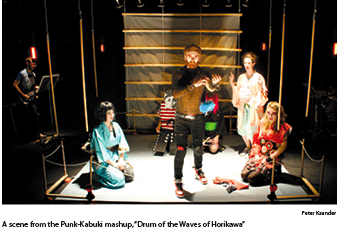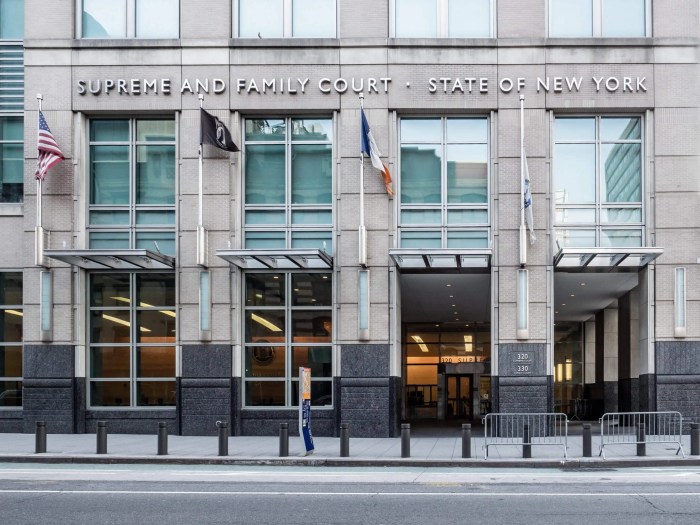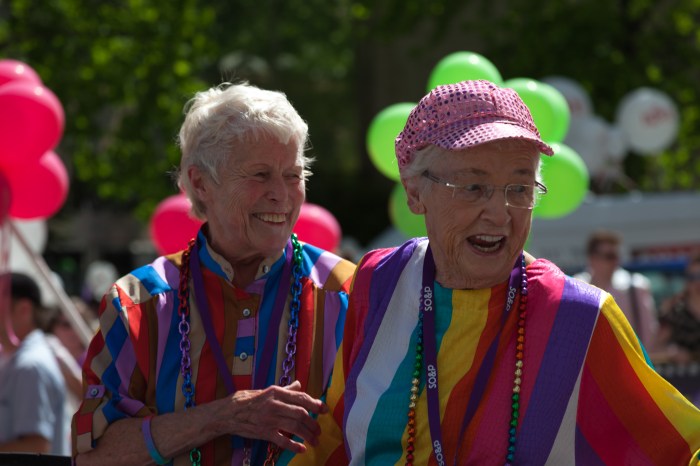By Adrienne Urbanski
The similarities between the refined art of traditional Japanese Kabuki theater and ’70s punk rock might not be obvious, but Theater of a Two Headed Calf’s production of “Drum of the Waves of Horikawa” explores the parallels between the two. The result is an incredibly innovative work, exploding with adultery, nudity, beheadings, and sword fighting.
The play is an adaptation of an English translation of a Monsaemon Chikamtsu play from 1705. The play’s many complex Shakespearean turns become somewhat lost amidst the thrashing, screams and often purposefully incomprehensible dialogue, but the essential plot remains intact: Ontane, the wife of a well established samurai, suffers from sexual unease during her husband’s prolonged absence, and attempts to fill her loneliness with endless cups of sake. Jess Barbagallo shines with comic energy as a lecherous lesbian samurai, ironically named Usogayman, who lunges and leaps across the stage as she hungrily grabs at the bodies of her attractive female cast mates. Her unwanted advances ultimately unleash an avalanche of sexual confusion and false rumors, and after too much sake Ontane finds herself in bed with her brother’s drum instructor. When her punk samurai husband discovers the truth, he seeks revenge against both his wife and her lover.
Director Brooke O’Hara took care to train the cast members in perfecting both punk and kabuki movement. Cast members prepared for their roles by studying videotapes of punk performers like Siouxise Sioux, The Germs, and Iggy Pop and emulating their stage movements. O’Hara then worked with the actors to blend a sense of Kabuki refinement into their work, and developed a unique movement style for each cast member.
Characters communicate their emotional unrest in a mix of both methods, sometimes screaming into an onstage microphone while thrashing about the stage, and sometimes freezing their faces into crossed eyes and distended tongue, the Japanese theatrical method known as mie. The play’s lines themselves are often lost and unintelligible, clearly the noise and emotion they convey is seen as more essential than what is actually being said. During moments of extreme unease the characters even belt out lines from old films like Preston Sturges’ “The Lady Eve,” perhaps commenting on the differing texts of Japanese and western storylines.
The mergence of cultures is particularly apparent both in the costuming and in the play’s score. The cast don eye-catching punkified kimonos, Crayola-colored hair, fishnets, samurai swords encased in blue and dramatic swoops of eye makeup. Composer Brendan Conelly skillfully merges both Japanese and punk influenced sounds into the play’s score, adding a driving energy to the work. Connelly, who plays keyboards for the show, is joined by two drummers and a bassist, all plucked from local punk acts. He also serves as the play’s MC, alerting the audience to the upcoming episode breaks (of which there are five) and to promote the purchase of cheap sake.
As if the screaming, thrashing, and beheadings were not assault enough on our senses, the play dabbles also in full frontal nudity, the intent behind which is never made clear, though it ties in well to the punk aesthetic.
While plot and emotion are somewhat drowned out in its noise, “Drum of the Waves of the Horikawa” wows in its ability to throw convention aside and successfully unify two drastically differing cultures.














